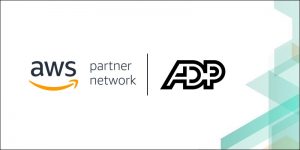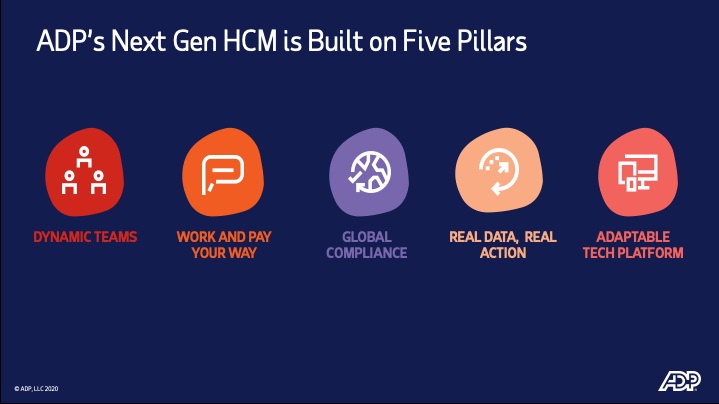AWS Partner Network (APN) Blog
ADP Transforms its Human Capital Management Technology with Support of AWS SaaS Factory
By Oded Rosenmann, SaaS Business Lead at AWS
 |
| ADP |
 |
To accelerate and guide the adoption of a software-as-a-service (SaaS) delivery model on Amazon Web Services (AWS), we launched the AWS SaaS Factory.
This program brings together a targeted combination of SaaS content, tooling, and embedded resources that provide AWS Partners with guidance, direction, and expertise to accelerate and improve the potential of a SaaS offering on AWS.
Recently, we had a chance to work with Automatic Data Processing (ADP), an AWS ISV Partner, and help build its next gen HCM solution as a SaaS offering on AWS.
ADP leveraged AWS services for its next gen human capital management (HCM) and payroll platform that helps organizations create highly personalized work and pay experiences.
ADP chose AWS as the cloud platform for their HCM system for its security, capability, and innovation. Using AWS services, ADP was able to build a solution that adhered to data and privacy requirements, while simultaneously focusing on latency, throughput, availability, elasticity, and data-modeling requirements.
Getting Started with ADP
The AWS SaaS Factory team spoke with Zaid Masud, Chief Architect at ADP, to learn about what they are launching and how it benefits customers.
We also asked what advice they have for other APN Partners building SaaS solutions on AWS.
Check out ADP’s next gen HCM solution >>
Q&A with ADP
SaaS Factory: Can you tell us about your background and personal experience with cloud computing?
Zaid Masud: My experience with cloud computing dates back to 2010. Before ADP, I was at an early-stage startup when cloud computing was starting to become mainstream. It enabled companies to get up and running with reliable infrastructure and focused on adding value to their customers, as opposed to spending an inordinate amount of time and effort on figuring that all out.
I joined ADP in 2014 as part of the innovation lab that went on to become ADP’s next gen HCM. When I started here, we were primarily running our own data centers. Over the next year, we effectively spearheaded the migration of our product into the cloud and inspired the broader ADP enterprise to move to the cloud as well.
SaaS Factory: What products and solutions has ADP built on AWS?
Zaid Masud: ADP’s next gen HCM is our Human Capital Management and Payroll platform built for the future of work, and it’s 100 percent on AWS. It’s a low-code app development platform that lets us build HCM apps quickly and with the degree of customization you need for HCM platforms.
ADP has built several other products on AWS, and is in the process of rearchitecting some of the products we host in-house to move them to the AWS Cloud.
SaaS Factory: How does the ADP’s next gen HCM solution work?
Zaid Masud: At the core of ADP’s next gen HCM solution is dynamic teams. Recognizing where the real work in organizations gets done drives both engagement and performance. Based on our adaptable technology, clients can create highly personalized work and pay experiences for all of their people by selecting and configuring ADP and third-party apps by function, location, team, or other factors.
Our clients can manage a global workforce and make data-driven decisions by leveraging AI-driven insights based on their data.
SaaS Factory: What are some of the key customer benefits?
Zaid Masud: When we looked at how we were going to do next gen HCM, we looked at which pillars made organizations successful from a team and work perspective. We then narrowed it down to five—dynamism, customization, data, compliance, and agility.
Dynamic teams get work done collaboratively, not in the traditional hierarchical organizational structures of the past. For customization, we looked at personalization and the ability to work and pay your way. We needed both extreme personalization and customization in the workplace, especially for customers with specific needs, including industry and regional considerations.
In addition, we realized companies are looking for actionable insights based on reliable data. Real data for real action. With one in six U.S. workers being paid with ADP, the amount of data we can leverage is fairly significant. The job reports from ADP—which can be tracked yearly, quarterly, and monthly—are reliable indicators of the economy. We’re able to aggregate data in a way that’s anonymized and intended to give customers actionable insights.
We also needed a solution that takes into consideration global compliance. Customers can manage a global workforce and easily make changes to adhere to location-specific compliance needs. In that regard, companies setting up offices in other countries know they can count on ADP to help.
Then there’s the most important aspect, in my opinion—the ability to be agile and nimble. We refer to that as adaptable technology. It’s the idea that as an organization, you can change as fast as your technology allows you to change.
SaaS Factory: Can you walk us through the architecture? What AWS services are key?
Zaid Masud: We employ a containerized microservice architecture with about 250 microservices running on Amazon Elastic Kubernetes Service (Amazon EKS). We have several different run times within our container and within our microservice ecosystem, including Node.js, Go, and Java Virtual Machine (JVM).
Using AWS services, we were able to build a solution that adhered to data and privacy requirements while simultaneously focusing on latency, throughput, availability, elasticity, and data-modeling requirements.
At the moment, we’re using Amazon Relational Database Service (Amazon RDS)—both the MySQL and PostgreSQL flavors. We’re also using Amazon DynamoDB primarily for key/value storage. We’re using Amazon Neptune for our graph database, which is what enables support of dynamic teams.
We use Amazon OpenSearch Service (successor to Amazon Elasticsearch Service) for free text search needs. We also use Amazon Kinesis for change data-capture use cases where we’re streaming data change events from system of record databases down to our graph database and other data sources.
SaaS Factory: What support did AWS SaaS Factory provide your team?
Zaid Masud: AWS SaaS Factory facilitated multiple onsite workshops with our team. AWS experts met with us to conduct full-day workshops that work through our current model and goals, helping us understand the trade-offs for the decisions we’re making.
We found AWS SaaS Factory put a significant amount of thought into multi-tenant SaaS models, both from the compute perspective, as well as the data perspective, which was important to us. It gave us a framework to work through our thought process in where we needed to go.
This work ultimately laid the foundations for our multi-region approach, which was necessary to set us up for global growth.
SaaS Factory: Was there an organizational transformation that needed to occur during your journey to SaaS model?
Zaid Masud: We had to create a plan to transition the organization and define what that would entail from an operational standpoint. ADP’s next gen HCM was a new product that was developed with a new team, more than 98 percent of which were new hires from the industry within the New York City tech space. We had people with entrepreneurial and startup experience.
During the early discussions on moving to the cloud, there was some resistance at ADP, but we were able to move forward. We had to build an understanding of where we would need centralized support both at the corporate level and business unit level. We had support from the C-level team on this, which helped the transition exponentially.
SaaS Factory: What would you tell others planning to build a SaaS solution on AWS?
Zaid Masud: Look at your multi-tenancy model and think about what isolation you need. Make sure you understand that where you start can set you up to evolve as time goes on and as you grow. For example, when using Amazon RDS, there are multiple ways to model your multi-tenancy and you should make sure you understand what these are and what’s best for you.
You also need to look at where you need to have more customized technology in place and where you’re OK using managed services.
Generally speaking, most challenges you have can usually be solved with a cloud-managed service. There are so many resources and avenues of support available from AWS to get those answers for you. It’s important to understand what those solutions provide and how they can meet your needs.
About AWS SaaS Factory
AWS SaaS Factory helps organizations at any stage of the SaaS journey. Whether looking to build new products, migrate existing applications, or optimize SaaS solutions on AWS, we can help. Visit the AWS SaaS Factory Insights Hub to discover more technical and business content and best practices.
SaaS builders are encouraged to reach out to their account representative to inquire about engagement models and to work with the AWS SaaS Factory team.
Sign up to stay informed about the latest SaaS on AWS news, resources, and events.
ADP – AWS Partner Spotlight
ADP is an AWS ISV Partner that leveraged Amazon Web Services for its next gen human capital management (HCM) and payroll platform that helps organizations create highly personalized work and pay experiences.
Contact ADP | Solution Overview
*Already worked with ADP? Rate this Partner
*To review an AWS Partner, you must be a customer that has worked with them directly on a project.

